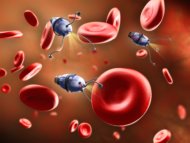Nanotechnology
Exploring Concepts, Possible Dangers
and its Affect on Medicine
The field of nanotechnology relates to the study and micromanipulation of nanostructure properties at dimensions between 1 and 100 nanometers.
Nano-science has a multitude of applications, including technology, manufacturing and medicine. This technology is on the verge of many innovative advances, which excites and concerns many scientists.
Basic Concepts
Researchers in nano-technological fields observe and manipulate anatomic properties of various materials up to 1 nanometer in size.
Nanotechnology continues to grow as a field and brings together a multidisciplinary group of researchers, including biologists, chemists, physicists and engineers.
Powerful microscopic instruments are required to observe the objects on a nanoscale.
Electron microscopes such as transmission electron microscopes (TEM)and scanning electron microscopes (SEM) provide topographical, morphological and compositional data.
Atomic force microscopes scan materials with a fine probe to create detail images.
In addition, nanomicroscopes allow researchers to view single molecules and micromanipulate individual atoms and molecules, rearranging them with a tiny probe.
The study of a substance on a nanoscale involves observation and experimentation.
The properties of many substances behave differently on a nano-level; an understanding of why and how this happens helps researchers to realize potential benefits and risks.

In addition, scientists experiment with micromanipulation and molecular manufacturing to gain further knowledge on substance properties as well as develop practical uses for this technology.
Knowledge of quantum mechanics, a branch of physics that focuses on subatomic particles, such as atoms, protons, neutrons and electrons, is required when observing the changes in behavior at the nanoscale.
Classical physics principles cannot explain instances such as static electrons moving and tunneling, insulators becoming semiconductors and changes in melting points.
Nanoparticles have a greater amount of surface area exposure, which make them ideal catalysts for chemical reactions; in addition, atoms are able to move more freely, around and between other atoms, creating an atmosphere where chemical properties can be altered.
Another reason for possible differences is the decreased effect of gravity and increased effect electromagnetic forces and thermal vibrations have on atom behavior.
Nanostructures
Scientists have discovered specific nanostructures that have practical uses today or in the near future; these structures include quantum dots (qdots), spherical fullerenes (buckyballs), cylindrical fullerenes known as carbon nanotubes and nanowires.
Many scientists believe that nanotubes and nanowires hold the most promise for possible developments.
Qdots are believed to have future applications in diagnostic testing, including the location of cancer cells.
This and related iron oxide, gold and magnetic nanoparticles have the ability to attach themselves to proteins and/or other molecules.
A number of companies are currently using these particles to advance diagnostic and imaging techniques.
Buckyballs are made up of carbon molecules and look like a soccer ball. They have technological applications in electronics and diagnostic medicinal tools.
Skilled scientists are able to recreate carbon nanotubes through the micromanipulation of atoms. With the right arrangement, nanotubes are stronger and more durable than steel and significantly lighter in weight.
Nanoengineers hope to use nanotubes as the basis of building materials for cars and airplanes. The stronger material will increase safety, while the lighter weight will increase fuel efficiency.
Researchers continue to use molecular manipulation to alter the arrangement of atoms in nanotubes in hopes of finding the right combination to use them in semiconductors, transistors and other electronics.
Nanowires are tiny wire researchers are able to replicate; they have a number of potential uses, including the possibility of being used in conjunction with nanotubes.
Most believe nanowires will be used in future computers and electronics, as transistors and semiconductors.
A number of commonly used products employing advances in nanotechnology include sunscreen, self-cleaning glass, scratch resistant coatings used on products like eyeglass lenses, antimicrobial bandages, swimming pool cleaners and disinfectants, wrinkle-resistant fabrics, cosmetics and LCD displays.
Nanotechnology Dangers
The riskiest aspects of nanotechnology are unknown dangers, misuse and harmful effects on health and environment.
Scientists continue to work toward finding practical applications of nanoparticles without truly knowing the potential effects of their innovations. Underlying risks are always present when technologies surpass human knowledge and understanding.
The ability to alter substances at a molecular level is a powerful skill and, left in the wrong hands, could lead to misuse.
One fear is manipulating particles to intentionally cause physical harm to one or more persons. Especially dangerous is the prospect of a terrorist applying this technology to create small, undetectable biological or atomic weaponry.
Ethical concerns of misuse also include the possibility of altering the genetic make-up of humans by engineering specific traits.
Such a procedure would be directed toward the high-income section of society and could further divide the population into a “super” class of intelligent, strong beings and a lower class of “average” people.
Particles on a nanoscale can cause toxic effects in humans; they are so small they have the potential to cross the blood-brain barrier, which could cause mass poisoning or unwanted neurological effects.
In addition, scientists do not know whether exposure to nanoparticles over long periods of time will affect the human body.
Although strict government guidelines exist to minimize potential dangers, some still believe it plausible that long-term exposure can cause a slow poisoning and future health issues.
Researchers do not know if nanoparticles pose potential dangers to the environment such as contamination of water supplies or harm to animal populations.
Dismissed by many scientists, some still fear the “grey goo” scenario. This scenario is based on the theory that nanorobots would self-replicate, cloning themselves until the entire organic world was consumed, leaving behind a giant mass of grey goo.
Although some of these are speculative, scientists have valid concerns regarding short and long-term threats to the human body and environment because of recent laboratory findings:
- Exposure to fullerenes killed water fleas
- Fullerenes caused extensive brain damage and changed the physiological make-up of fish
- Earthworms absorbed fullerenes that easily traveled through soil
- Nanoparticles built-up in the bodies of lab animals subjected to long-term exposure
- Qdots caused cadmium poisoning in humans
- Nanoparticles can travel through a mother’s placenta
- Nanoparticles can assist in the formation of free radicals
The real and potential risks associated with nanotechnology raises much concern; although there is no quantitative way to determine if the benefits outweigh the risks.
Nanotechnology: Advantages and Disadvantages
Many potential applications and advantages include:
- Advances in disease treatments, such as cancer
- Better imaging and diagnostic equipment
- Energy-efficient products such as fuel and solar cells
- Improvements in manufacturing that allow for durable, light-weight, efficient production tools
- Improved electronic devices, including transistors, LED and plasma displays and quantum computers
- Nanorobots can be used to rebuild the ozone layer, clean polluted areas and lesson dependence on non-renewable energy sources
Disadvantages include:
- Potential dangers to humans and the environment
- Loss of manufacturing and agricultural jobs
- Economic market crashes related to a potential lower value of oil due to more efficient energy sources and gold or diamonds, materials that can be reproduced with molecular manipulation
- Accessibility of weapons of mass destruction
- Improved atomic weaponry
- The cost of research and products made from nanoparticles
Nanotechnology in Medicine
Many exciting innovations in the field of medicine are related to developments in nanotechnology.
These include advancements in imaging and diagnostic tools, drug delivery systems, treatment practices, anti-microbial options and cell repair and regeneration.
Researchers are currently developing ways to use nanoparticles to delivery medications directly to specific cells.
This is especially promising for the treatment of cancer cells, as chemotherapy and radiation treatments can cause damage to affected and healthy cells.
Targeted drug therapies deliver medication directly into the affected cells, increasing efficacy and decreasing potential side-effects.
Micromanipulation of nanoparticles can arrange atoms to attract affected cells, which can also aid in earlier diagnosis of diseases such as cancer.
Nanoparticles can also be used in emergency settings. Buckyballs can be manipulated to have anti-inflammatory properties to stop allergic reactions; nanoparticles can also reduce bleeding and speed coagulation.
Diagnostic testing and imaging can be improved by arranging nanoparticles to detect and/or attach themselves to specific proteins or diseased cells and enhance MRI imaging.
Antimicrobial bandages are currently available on the market, but there are many other possible uses. Creams can be used to attack infections and treat wounds; burn dressing treated with antimicrobial nanocapsules can prevent and treat infections.

In the future, nanorobots could be encoded in such a way that they repair damaged cells similar to the body’s innate method of healing.
The applications of nanotechnology in the field of medicine have the potential to increase life spans, diagnose and treat disease more effectively and provide therapies that closely mimic the body’s natural health processes.
Nanoscience and Microscopy
The Scanning probe Microscope is used when an image to the nanometer scale is needed. A raster pattern is formed over the surface of a specimen by using a sharp tip. Information is then stored to the nano-detail, the image is assembled and viewed on screen.
There are certain categories recognized within Scanning Probe Microscopy for use in nanoscience/nanotechnology developments, two of which are:
Scanning Tunneling Microscope (STM) -In this case the tip passes very close to the surface at the same time that the microscope applies an electrical voltage. This tunneling current is recorded.
This creates an image showing miniscule details on an atomic level.
Atomic Force Microscope (AFM) - uses a cantilever with a sharp probe that scans the surface of the specimen forming the image.
When the tip of the probe travels near to a surface, the contact forces between the tip and sample deflect the cantilever. Working according to Hooke’s law.
Magnetic Force Microscopy (MFM) - A variant of Atomic Force Microcopy
Nanotechnology has many present and future applications including innovations in electronics, manufacturing, renewable energy and medicine. Scientists are just beginning to understand the true potential of nanoparticles as well as the potential dangers.
Nanobots - With future applications in medicine and industry, scientists envision the manufacture of a functional nanite in approximately 25 years. Read on!
Carbon Nanotubes - While carbon nanotubes are complex structures, one can easily come to understand them and their many functions when broken down into individual components. Lets look at properties, modifications and their use in Atomic Force Microscopy.
Microscopy in Biotechnology - Biotechnology is advanced and made more profitable through the extensive use of microscopy. Improvements in microscopy techniques will provide the necessary springboard for scientists to improve product functionality.
Nanotechnology Products - In medicine, sports, transportation and environment.
And Nanotherapy - Current Research, learning about Nanoparticles
Return from Nanotechnology to Best Microscope Reviews Home
Find out how to advertise on MicroscopeMaster!




